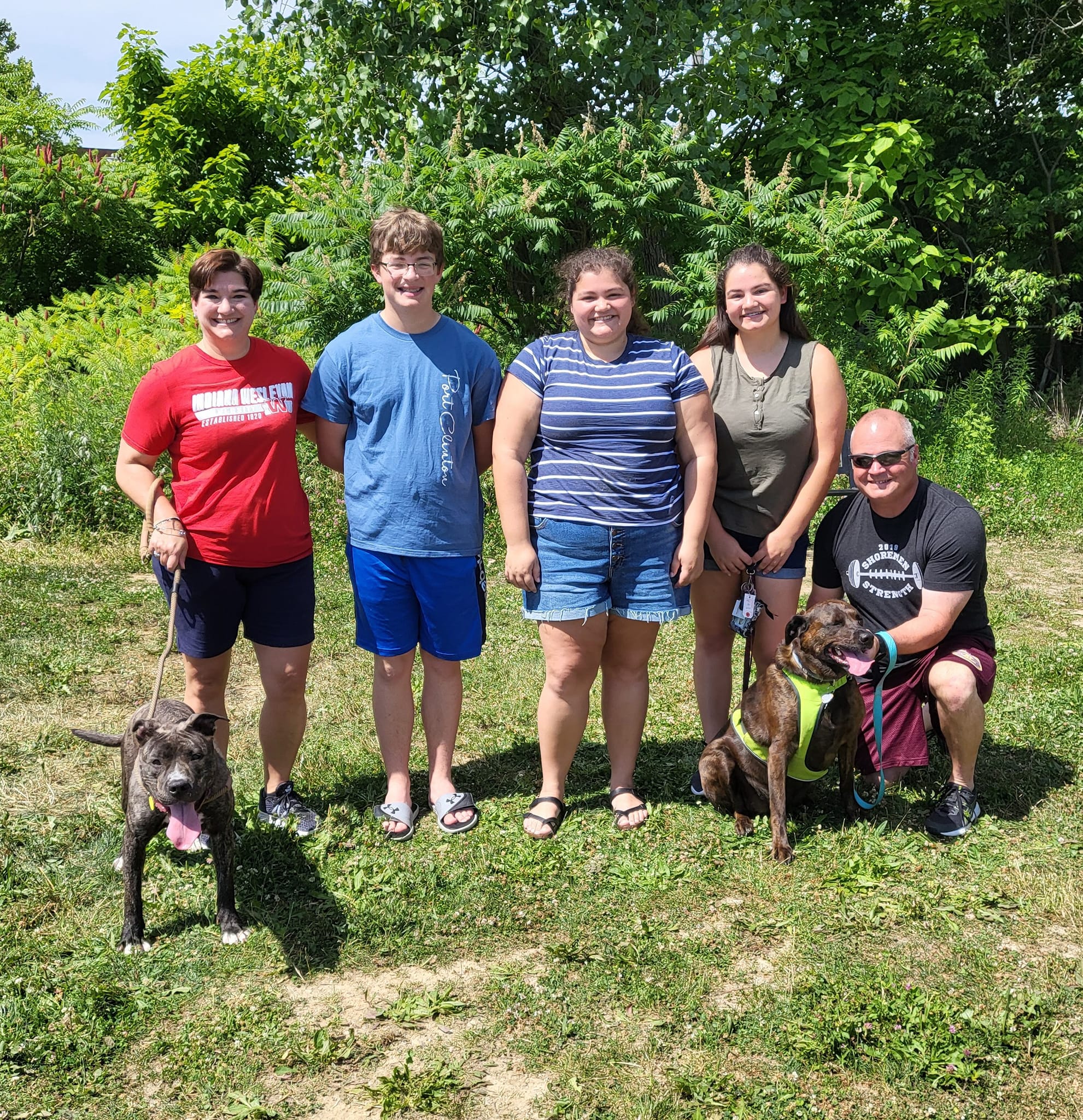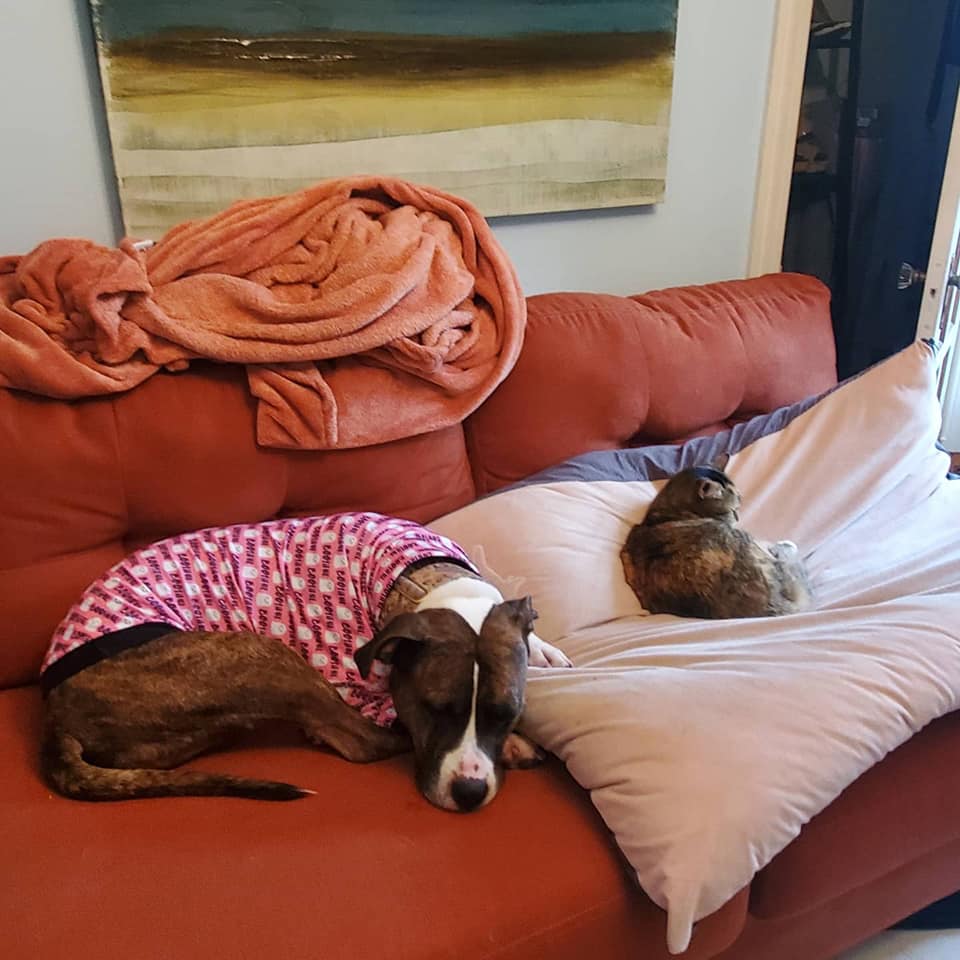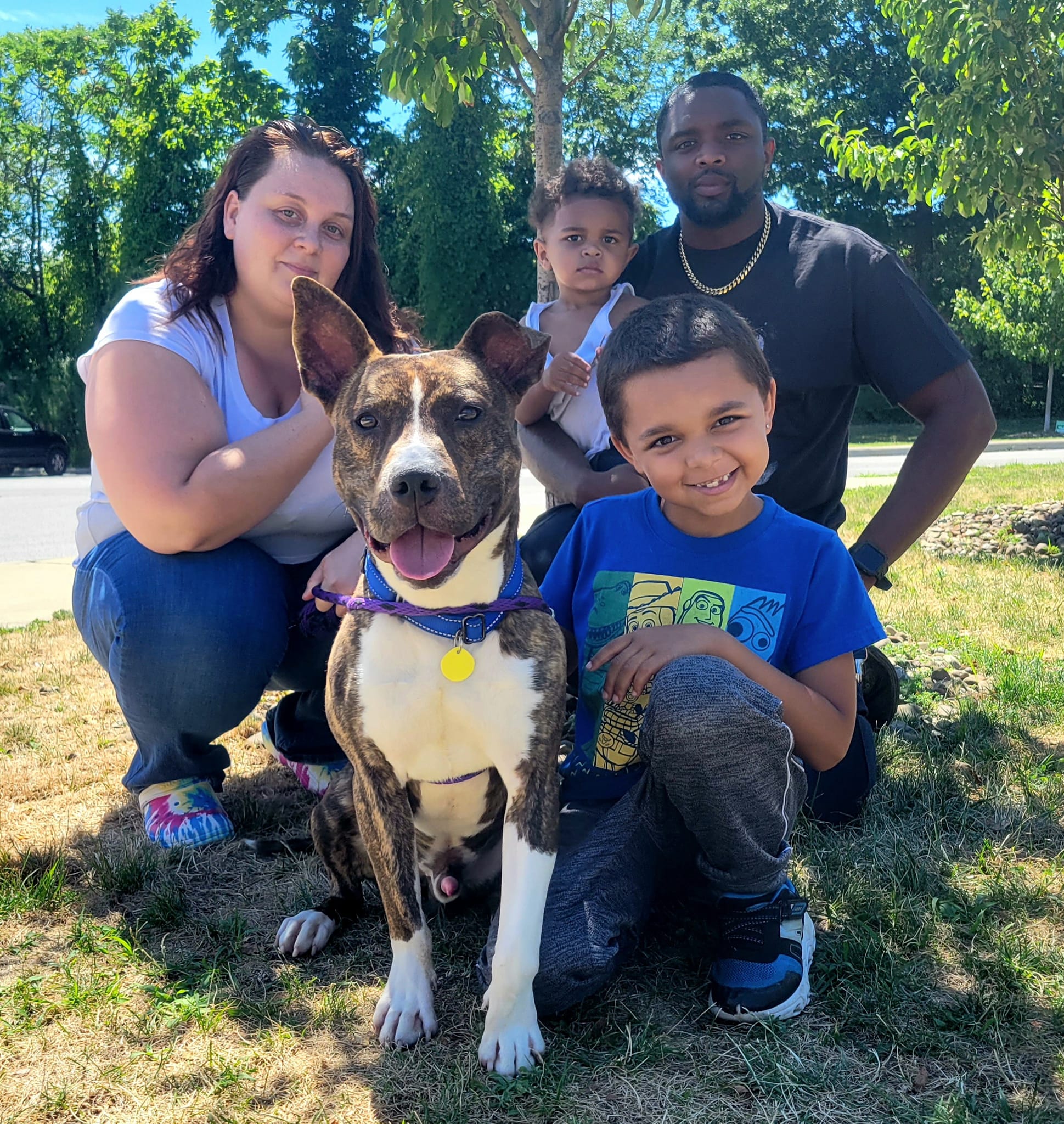Bringing a Dog Home
Adopting a new dog can be an incredibly fulfilling experience and a way to find a new best friend! While many happy years lie ahead, almost every new adopted dog is going to take time, patience and in all likelihood, training, in order to succeed.
Because the dog is likely used to a different human taking them out each day, it can take time to build trust. As tempting as it is to smother the dog in love at first, be sure the dog has her own space to go when she is tired or feeling overwhelmed. This might be a dog bed, crate, or their own room. This is especially important with kids in the house.
Avoid Overstimulation
Similarly, it can be very tempting to want to introduce your dog to all your friends and family or start taking them to busy places right away. But the kindest thing you can do for your new dog is be patient and hold off on these big exciting things until you get to know each other better.
Spend the first few weeks letting the dog get to know you, and letting yourself get to know their true personality as it emerges, including what they are and are not comfortable with. Work on basic training with positive reinforcement so you have a baseline for communication. Too much stimulation or new experiences right off the bat may cause a dog to overreact out of stress or defensiveness.
Expect Setbacks
Don’t panic if you have a setback. There will probably be some messes at first. Don’t be discouraged if things don’t go the way you expected or hoped right away. Those of us who have adopted before can say honestly that those first few nights are stressful! But once you get over the hump and the dog starts settling in, it’s all worth it. Most dogs will quickly pick up on house training and crate training with consistency.
The early days can even be a little challenging, but these deserving dogs are worth the effort! It helps very much to have reasonable expectations and a plan in place. The following information can help you be better prepared to help your new family member succeed!
Decompression
Any dog going through a big change in lifestyle, especially a dog coming from a busy kennel environment, is going to need some time to unwind and adjust.
In the first few weeks, it’s important to keep things simple and not to ask too much of your new dog. Be prepared to focus on building a bond and establishing a routine.
It takes most dogs a few weeks, if not months, to fully decompress, while some take even longer to “click.” But it’s worth the wait!
Here are some common behaviors you might see while a dog is adjusting to a new home. These are all normal and it may take a little time and patience to work through them:
- Catching up on sleep - Some dogs will want to spend the first day or two at home sleeping. The kennel can be a loud, stressful environment, and they might not have had a relaxing place to unwind for a while.
- Antsy or restless behavior - Some dogs will struggle to relax in a new place. They might pace or pant excessively, whine, and not want to settle down right away. Try to wait it out - all dogs will sleep eventually.
- Accidents - Even if a dog is housebroken, accidents are normal in the first few days while they learn their new schedule. Don’t punish the dog - try to give them more frequent bathroom breaks and watch for cues that they need to go.
- Aloofness - Some dogs might be anxious or distracted by the big change in environment. Don’t worry if your dog doesn’t seem that “into” you right away. They might need a little time to figure out where they are.
- Clinginess - On the other hand, some dogs won’t want to leave your side. Enjoy the snuggles but practice hanging out together, or being nearby, so the dog doesn’t become overly dependent.
- Barking or startling at strange noises - Dogs will likely get used to the sounds of the fridge, or neighbors outside, with time.
Ways to structure the first few days
- Take the dog straight home from the kennel.
- Take some long walks around the neighborhood or hang out together in the backyard so the dog can go to the bathroom, get to know their new environment, and get exercise.
- Pay attention to the dog’s body language and respect the signs they are giving.
- Keep a leash dragging on the dog’s collar while they are in the home to avoid needing to grab their collar or shout, both of which can be scary for a new dog.
- Keep the dog securely on-leash or in a completely fenced-in yard.
- Limit the dog’s access to the home at first so that you can keep an eye on them, and expand it gradually.
- Keep the new dog totally separate from resident pets for the first few days.
- “No new faces, no new places” - limit the number of visitors or trips to busy places at first.
Introducing a Dog
Meeting Other Dogs

If you already have a dog(s) at home, we ask that they come to a meet and greet at the kennel to meet any dog(s) you are considering for adoption.
Even if it goes well at the kennel, we always suggest doing gradual introductions at home. Remember, it’s a big transition for a new dog and you don’t want to overwhelm them with too much all at once!
Assume it will take roughly two weeks to get a new dog fully integrated with your dog(s) at home. However, all dogs are different, and some may need more time.
10 steps to introduce dog(s) at home:
- Set up your house in advance so you can keep the new dog completely separate from the resident dog to decompress without being overwhelmed.
- Plan to bring home the new dog separately from resident dogs, either with one or both in a crate rather than both loose together in the car.
- For the first few days, keep dogs totally separate in the house. A good reminder is, “smell before see, see before touch.”
- Take the dogs for tandem walks together around the neighborhood. Outdoor walks allow dogs to hang out together in a more neutral, open environment than a home. Start out from a distance and bring dogs closer only if they are comfortable and relatively calm.
- Once you feel the dogs are no longer a novelty to each other, you can proceed to short hang-out/play sessions. Take the dogs for a short walk together and end in a fenced-in yard or walk into the house together. If everyone is comfortable, drop the leashes and let the dogs interact.
- After a few minutes of good playtime or hanging out, take a break. This way, you end on a high note, and the dogs should have a positive association with each other for the next time they meet.
- Over time, work up to longer and longer periods with the dogs hanging out together until you feel comfortable with them being out together anytime you’re there.
- Remove toys, bones, and treats when new dogs are first interacting. Even if your dog isn’t usually interested in toys, the dynamic might change with a new dog. Only introduce them once dogs get to know each other.
- Remember, it is okay if new dogs are not best friends right away. Many differences in play style or energy can be figured out with some time, space, and patience.
- If you hit a wall with integration, reach out to your adoption counselor or to one of our recommended professional trainers!
Meeting Cats

If you have cats at home, we always recommend taking it slow when introducing a new dog . Assume it will take at least a few weeks, maybe more, to get a new dog integrated with cats. Even if they are initially overly excited or inclined to chase, many dogs can learn to live with specific cats with some time and training.
Testing Things Out
Can we “cat test” dogs? Our options to do this at the kennel are limited. Sometimes, we can walk a dog by an outdoor cat to gauge its reaction. We will always share if we have observed a dog showing prey drive or ignoring a cat, for example, but this is not always an accurate reflection of how a dog will respond to a cat in a home once he starts feeling more comfortable and confident. Plan to take it slow.
Tips for a Successful Introduction
For at least the first few days, keep the cats and new dog totally separated. There should be a closed door between them. Give the new dog at least a few days to decompress and get used to the home so you know that an initial reaction to a cat isn’t just a result of the excitement of everything being new.
When it’s time for the dog to see the cat, keep the dog on a leash and make sure the cat has multiple options to escape. Start from a distance. Let the dog see the cat. If the dog can remain calm seeing the cat, and you can get the dog’s attention easily by calling their name, reward the dog with treats.
Over time, work up to shorter distances and longer times with the dog and cat in proximity until you feel comfortable with the dynamic. We do not recommend leaving new pets together unattended.
If you ever feel stuck or uncomfortable with what you are seeing, we encourage you to give it time or to consult a trainer. Suggestions/resources can also be provided to adopters by their adoption counselors.
Meeting Children

Many dogs from a shelter can make great family companions. Some dogs may be more comfortable, or manageable, around children than others. Children in the home should come to the meet and greet.
Even if it goes well at the kennel, it’s important to set everyone up for success at home. Just as it’s key to train dogs to be behaved around children, it’s necessary to teach children how to be appropriate with animals, too!
Here are some suggestions to keep in mind:
- Create a safe space for the dog to go for quiet or down time. A crate works great for this. Be sure to teach children that they should not bother a dog while in their crate or other space.
- Don’t allow children to bother dogs while they are eating or to fuss with/take a treat or toy they are working with. This is especially important while the dog is adjusting and you are still getting to know them.
- Teach children not to be too rough with the new dog - no ear or tail pulling, laying or jumping on the dog, etc.
- When children are running around or having loud/exciting play time, keep the dog on leash until you know he won’t try to join in and play too exuberantly or roughly.
Training
With any new dog, expect the need to do some basic training. We strongly suggest using positive reinforcement training methods with your new dog.
Here are some common things for which new dogs may need training :
House Training
Even if a dog seems mostly housebroken, they might have a few accidents as they are adjusting.
When you first bring a new dog home, plan to give them frequent potty breaks so they can figure out where to go. Gradually increase the amount of time between potty breaks. Most healthy adult dogs should be able to adjust to “holding it” through a full-time work day.
Crate Training
We highly suggest crate-training your new dog. Crating your dog while they are home alone can help keep them and your household safe keeping the dog from getting into anything it shouldn’t, or from having accidents throughout the house while unattended.
The crate should never be a punishment; make it a comfortable place with a blanket or bed, some water, and treats. During the first few days at home, you can leave the crate open so the dog can come and go freely. Try feeding them meals inside the crate to build a positive association. After a few months, you may decide the crate is no longer needed and your dog can be trusted to be loose in the house.
Note: Some dogs have confinement anxiety rather than separation anxiety, and don’t enjoy being crated. It can take some trial and error - such as leaving a dog baby gated into an area of the house, or in their own room - to find the right set-up.
Leash Manners
It is common to need some training for a dog to not pull on a leash. Reactivity, or reacting to a stimulus, often by jumping/barking/lunging, is another behavior that can be caused by excitement or fear.
We recommend carrying training treats on walks so you can practice sitting/watching and reward your dog for calmly watching other dogs or animals pass by.
Jumpiness
Some dogs can be jumpy when excited, especially when someone walks in the front door! Practice keeping “four on the floor” by giving a dog attention or treats only when they have all four paws on the ground (not when they are standing/jumping.)
Keeping a leash dragging on a dog’s collar for the first few days also allows you to step on it if the dog is overwhelming a child (or adult) by jumping.
Mouthiness
Sometimes when dogs are excited or stressed, they will “mouth” on people like they would play with another dog. This can be nibbling, flea biting, or play biting.
If a dog is mouthing, try to calmly but firmly tell them “uh-uh” and remove your arm or clothing from the dog and ignore them. You can also offer a chew toy instead, or yelp like a puppy to indicate they hurt you. You can also try teaching a dog a solid command like “sit” to try and redirect their attention to something appropriate.
Especially in the first few weeks home, if your dog is mouthy, pay attention to activities that get the dog too excited - such as wrestling, running, or even cuddling - and try to avoid these activities so the dog can stay calm.
Shyness/Nervousness
Some dogs may become nervous about new people. This may happen when you have the first guests in your house. The first time(s) you have a guest over, plan to bring your dog outside on leash. Tell the new person to ignore the dog so that the dog can approach at their own pace and sniff. Once they seem comfortable, have everyone walk in the house together. This way, you remove the chance of a new person startling the dog by entering the house.
Resources
At first, new dogs might be uncomfortable sharing their resources, such as food or high-value treats like bones/bully sticks. When you need to get something away from a dog, trade him for something else (like a higher value treat). You don’t want to make the dog feel like they have to protect their newly acquired possessions from being taken randomly. Working on the commands “drop it” or “leave it” early on can help enormously with this.
The paperwork you get when you adopt your dog will include some further resources/reading on these subjects. Be sure to reach out to your adoption counselor or the CITY DOGS adoption team (citydogs@clevelandohio.gov / 216-664-3476) with questions.
Resources
Low-Cost Pet Care
There are organizations that strive to provide low-cost services to pet owners in the City of Cleveland. If you are looking for a little extra help, check out these resources. It’s best for everyone if pets can stay in their loving homes!
Companion Pets of Cleveland
https://companionpetsofcleveland.com/
5376 Ridge Road, Parma OH 44129
216-307-7814
“Companion Pets of Cleveland strives to help families and their companion animals stay together during financially difficult times, times that could easily separate them because of the owner’s inability to provide food, supplies, and other basic needs. We provide pet food, cat litter, and other basic supplies through our pet food pantry. We may be able to subsidize vet costs as well.”
Neighborhood Pets
https://www.neighborhoodpetscle.org/
3711 E 65th St, Cleveland OH 44105
216-505-5853
“Recognizing the many benefits of the human animal bond, Neighborhood Pets supports people with financial needs by helping them keep their pets in their homes. We do this by providing access to affordable pet care, resources, information and other supportive services. Our welcoming environment is designed to foster trust and create long lasting relationships as we build community.”